Discover Florida Nature
It's time to explore the natural Florida


|
|
|
|
|
Amphibians have a high success rate in Florida. There are currently no
endangered or threatened amphibians listed by the State of Florida but
there is one federally endangered amphibian (Reticulated Flatwoods
salamander) one federally threatened
amphibian (Frosted Flatwoods salamander) and four species of special concern in the state of Florida. For
further information on Florida, you may want to purchase a book from our
Florida Nature Library. Don't miss our "Nature
Videos" slideshow set to music! The five species of special concern
are listed below: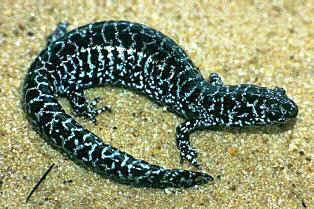 Reticulated Flatwoods
Salamander (Ambystoma bishopi) The reticulated Flatwoods
salamander is a species of mole salamander that is native to a
small portion of the southeastern coastal plain in the western panhandle
of Florida and extreme southwestern Georgia, occurring west of the
Apalachicola River. Reticulated Flatwoods salamanders feed on earthworms
and spiders for the most part part. They are a long slender salamander
that can get to be about ranges in length from five inches to almost 5
1/2 inches in length. These endangered salamanders migrate to ponds or
other small fresh waterways to breed between the months of October and
January. The female reticulated Flatwoods salamander lays a clutch of
eggs hidden in sticks or twigs along the shoreline. The clutch,
consisting of no more than 35 eggs hatches in approximately 48 hours.
The main risk for these salamanders is their loss of habitat due to an
increase in agriculture and threats to the water table also pose a
threat because the water is necessary for the eggs to hatch. Reticulated Flatwoods
Salamander (Ambystoma bishopi) The reticulated Flatwoods
salamander is a species of mole salamander that is native to a
small portion of the southeastern coastal plain in the western panhandle
of Florida and extreme southwestern Georgia, occurring west of the
Apalachicola River. Reticulated Flatwoods salamanders feed on earthworms
and spiders for the most part part. They are a long slender salamander
that can get to be about ranges in length from five inches to almost 5
1/2 inches in length. These endangered salamanders migrate to ponds or
other small fresh waterways to breed between the months of October and
January. The female reticulated Flatwoods salamander lays a clutch of
eggs hidden in sticks or twigs along the shoreline. The clutch,
consisting of no more than 35 eggs hatches in approximately 48 hours.
The main risk for these salamanders is their loss of habitat due to an
increase in agriculture and threats to the water table also pose a
threat because the water is necessary for the eggs to hatch. 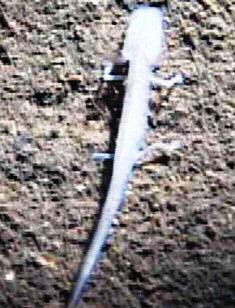 Georgia
Blind Salamander (Haideotriton wallacei)- The Georgia Blind
Salamander no eyes or pigment. It has bright red feathery external
gills, long, thin legs, and a finned tail. It reaches a length of only
3". Its name is due to the fact that the specimen was first discovered
in a 200 foot well in Albany, Georgia. It has since been discovered in
Climax Cave in Decatur County Georgia, but for the most part they are
distributed in 11 cave systems along the Florida Panhandle around
Jackson County. The Georgia blind salamander is the only vertebrate cave
dweller in Floridian caves. Georgia blind salamanders live a slow-moving
life, creeping over the bottom and up along walls of caves. They are
more common close to cave entrances, as food is more plentiful here.
They feed on a variety of cave crayfishes, isopods, copepods, and
detritus. Because of its limited distribution, the Georgia blind
salamander has been seriously threatened by habitat loss. As a result
the species is now protected in both states where they reside. Georgia
Blind Salamander (Haideotriton wallacei)- The Georgia Blind
Salamander no eyes or pigment. It has bright red feathery external
gills, long, thin legs, and a finned tail. It reaches a length of only
3". Its name is due to the fact that the specimen was first discovered
in a 200 foot well in Albany, Georgia. It has since been discovered in
Climax Cave in Decatur County Georgia, but for the most part they are
distributed in 11 cave systems along the Florida Panhandle around
Jackson County. The Georgia blind salamander is the only vertebrate cave
dweller in Floridian caves. Georgia blind salamanders live a slow-moving
life, creeping over the bottom and up along walls of caves. They are
more common close to cave entrances, as food is more plentiful here.
They feed on a variety of cave crayfishes, isopods, copepods, and
detritus. Because of its limited distribution, the Georgia blind
salamander has been seriously threatened by habitat loss. As a result
the species is now protected in both states where they reside.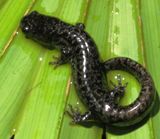 Frosted
Flatwoods Salamander (Ambystoma cingulatum) The frosted
Flatwoods salamanders listed as federally threatened. This salamander is
about the same size as other flatland salamanders, reaching a length of
a little over five inches. The Frosted Flatland salamander has a silvery
gray or black body with white spots that are less distinct than on the
reticulated Flatwoods salamander, and have a small head and a black
belly. Spiders and earthworms are the most common foods for the
salamander who is found in longleaf pine Flatwoods that have scattered
wetlands for the salamanders to hatch their eggs in. Frosted Flatwoods
Salamanders are found east of the Apalachicola River in Franklin,
Wakulla, Liberty, Jefferson, and Baker counties. Frosted
Flatwoods Salamander (Ambystoma cingulatum) The frosted
Flatwoods salamanders listed as federally threatened. This salamander is
about the same size as other flatland salamanders, reaching a length of
a little over five inches. The Frosted Flatland salamander has a silvery
gray or black body with white spots that are less distinct than on the
reticulated Flatwoods salamander, and have a small head and a black
belly. Spiders and earthworms are the most common foods for the
salamander who is found in longleaf pine Flatwoods that have scattered
wetlands for the salamanders to hatch their eggs in. Frosted Flatwoods
Salamanders are found east of the Apalachicola River in Franklin,
Wakulla, Liberty, Jefferson, and Baker counties.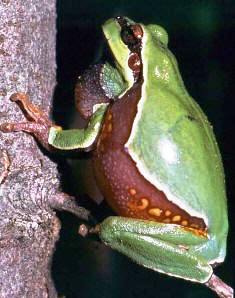 Pine
Barrens Treefrog (Hyla andersonii)- The Pine barrens tree frog
is only about 1–3 inches long and is one of the smaller species of tree
frogs. Members of the species are predominantly green, with wide dark
stripes. They often have spotted orange-gold markings on the hidden
surfaces of their legs, and also tend to have large toe pads. Pine
Barrens tree frogs are most commonly found in brushy areas, often near
peat bogs or shallow ponds. They usually inhabit areas carpeted with
thick moss. Adults are terrestrial, but tend to reside near water
sources. Unlike most frogs, Pine barrens tree frog are tolerant of low
pH levels, and often lay eggs in shallow, acidic ponds. Members of the
species are currently distributed in three distinct populations: New
Jersey Pine Barrens, the Sandhills of North and South Carolina, and the
Florida Panhandle area. Pine
Barrens Treefrog (Hyla andersonii)- The Pine barrens tree frog
is only about 1–3 inches long and is one of the smaller species of tree
frogs. Members of the species are predominantly green, with wide dark
stripes. They often have spotted orange-gold markings on the hidden
surfaces of their legs, and also tend to have large toe pads. Pine
Barrens tree frogs are most commonly found in brushy areas, often near
peat bogs or shallow ponds. They usually inhabit areas carpeted with
thick moss. Adults are terrestrial, but tend to reside near water
sources. Unlike most frogs, Pine barrens tree frog are tolerant of low
pH levels, and often lay eggs in shallow, acidic ponds. Members of the
species are currently distributed in three distinct populations: New
Jersey Pine Barrens, the Sandhills of North and South Carolina, and the
Florida Panhandle area.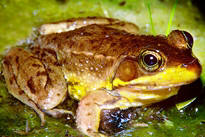 Florida
Bog Frog (Rana okaloosae)- Bog Frogs have rough dark green to
brown backs, black mottled undersides, yellow throats, and may have
light spots on the lower jaw. A light brown line runs along the lateral
fold and does not reach the groin area. This frog is less than 2 inches
long. This frog is uncommon in Florida and is found only in a few acidic
streams in Walton, Santa Rosa, and Okaloosa counties in the panhandle.
The Florida bog frog will call from spring to summer with a call which
sounds like a chuckle -- a series of low-pitched single clucking calls,
noticeably slower at the end of the call. Florida
Bog Frog (Rana okaloosae)- Bog Frogs have rough dark green to
brown backs, black mottled undersides, yellow throats, and may have
light spots on the lower jaw. A light brown line runs along the lateral
fold and does not reach the groin area. This frog is less than 2 inches
long. This frog is uncommon in Florida and is found only in a few acidic
streams in Walton, Santa Rosa, and Okaloosa counties in the panhandle.
The Florida bog frog will call from spring to summer with a call which
sounds like a chuckle -- a series of low-pitched single clucking calls,
noticeably slower at the end of the call.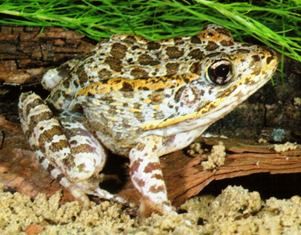 Gopher
Frog (Rana capito)- These nocturnal frogs are noted for their
short, stubby appearance. Their backs are marked heavily with dark
spots, sometimes causing a clouded pattern. Their dorsolateral ridges
are very distinctive. This frog will reach a length of 4.33 in. The
gopher frog usually spends daylight hours in burrows, holes, or tunnels
that are created by other animals. The Gopher frog primarily inhabits
the threatened sandhill communities, flat woods, and scrub in the
Atlantic coastal plain, where it
is usually found near ponds. The gopher frog breeds on spring nights in
very wet conditions. They seem to be rare, but their secretive nature
makes it difficult to determine their true population status. Gopher
Frog (Rana capito)- These nocturnal frogs are noted for their
short, stubby appearance. Their backs are marked heavily with dark
spots, sometimes causing a clouded pattern. Their dorsolateral ridges
are very distinctive. This frog will reach a length of 4.33 in. The
gopher frog usually spends daylight hours in burrows, holes, or tunnels
that are created by other animals. The Gopher frog primarily inhabits
the threatened sandhill communities, flat woods, and scrub in the
Atlantic coastal plain, where it
is usually found near ponds. The gopher frog breeds on spring nights in
very wet conditions. They seem to be rare, but their secretive nature
makes it difficult to determine their true population status. |
|
|
Advertise | Privacy Statement | Dog Encyclopedia | Video |Contact | Alaska Nature |
|